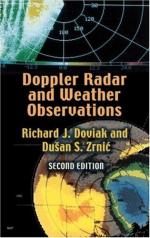|
This section contains 409 words (approx. 2 pages at 300 words per page) |
 Doppler radar dishes. National Oceanic and Atmospheric Administration (NOAA).
Doppler radar dishes. National Oceanic and Atmospheric Administration (NOAA).
Radio Detection And Ranging systems, known as radar, were developed in Britain in the 1930s as a defense against German bombing raids. While their military use flourished during World War II, radar was not used commercially until the 1950s. Today, radar has become commonplace. Flight crews routinely use radar-tracking features to navigate aircraft to their destinations safely. Radar is also commonly used by meteorologists to track weather patterns. For most television viewers of the weather forecast, the image of a green, circular radar screen—complete with a sweeping arm of light—is a familiar one. Using a high-intensity microwave transmission, meteorologists can detect and follow large masses of precipitation, whether they occur as rain, snow, or clouds.
A weather radar projection begins with a pulsed microwave beam that travels until it hits an obstacle (for meteorological purposes, a cloud or band of precipitation). It is then reflected back to the source, where it is received by a radar antenna. By measuring the time taken for the signal to reach the obstacle and return, its distance can be easily calculated. With thousands of pulses emitting and returning, a two-dimensional image of the weather formation is displayed on a cathode-ray tube, showing its precise position. A more elaborate version of radar tracking, called Doppler radar, uses a continuous signal rather than a pulsed wave. Doppler radar can determine both the direction and velocity of wind patterns, as well as areas of precipitation. Doppler radar measures the shift in frequency caused by a moving particle. If the returning frequency is higher than when transmitted, the particle is moving toward the source; if it is lower, the particle is moving away. However, the system only works when a particle is approaching or receding from the transmitter; Doppler radar cannot detect the velocity of a particle moving perpendicular to the radar signal. For this reason, signals from more than one radar source must be combined to produce an image free of gaps.
Unlike standard radar, a Doppler system can reliably detect the presence of funnel clouds and tornadoes, and is now used quite commonly by weather forecasters, as well as radio and television stations, to monitor thunderstorms for the presence of strong winds and tornadoes. Doppler radar can provide potentially life-saving readings at a relatively small cost increase over standard radar.
See Also
Air Masses and Fronts; Weather Forecasting Methods; Weather Satellite
|
This section contains 409 words (approx. 2 pages at 300 words per page) |


